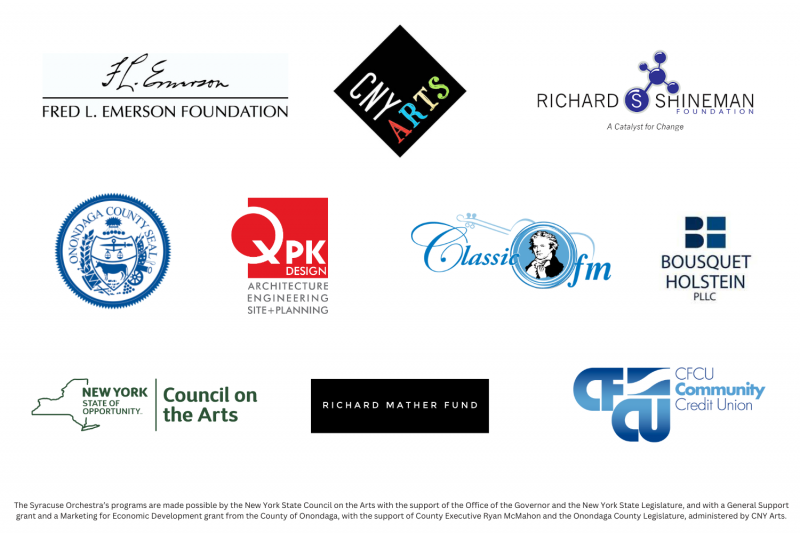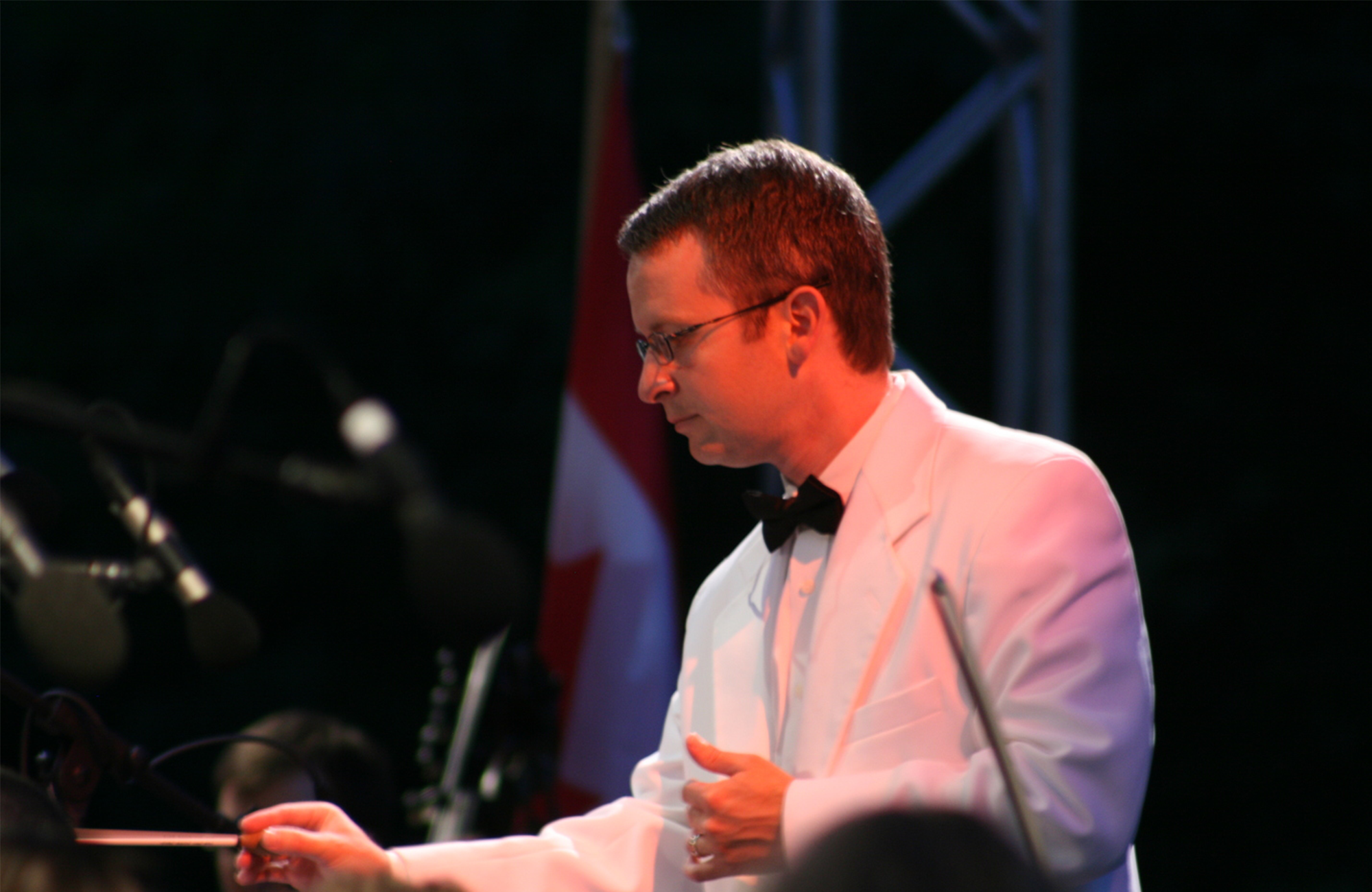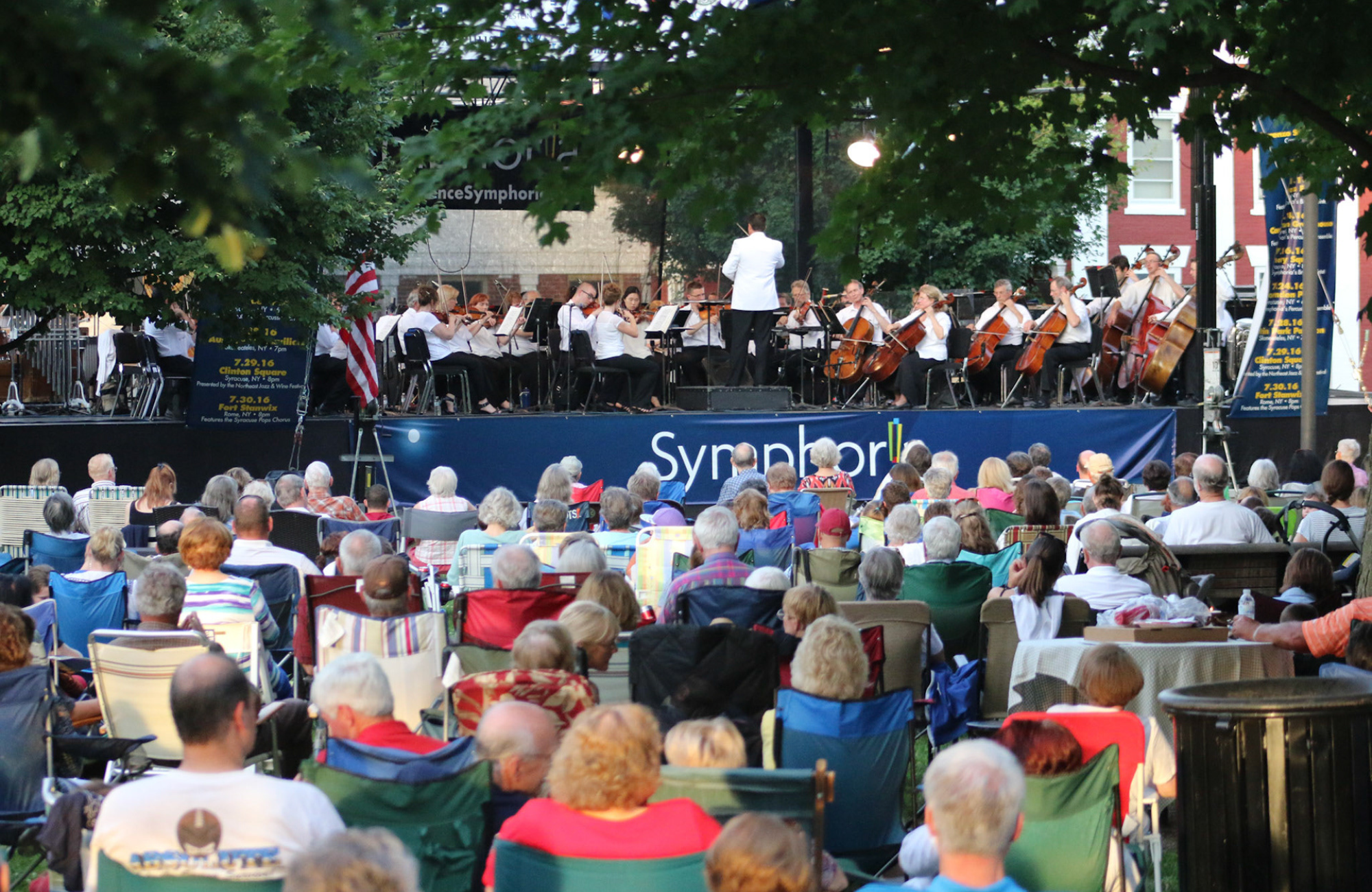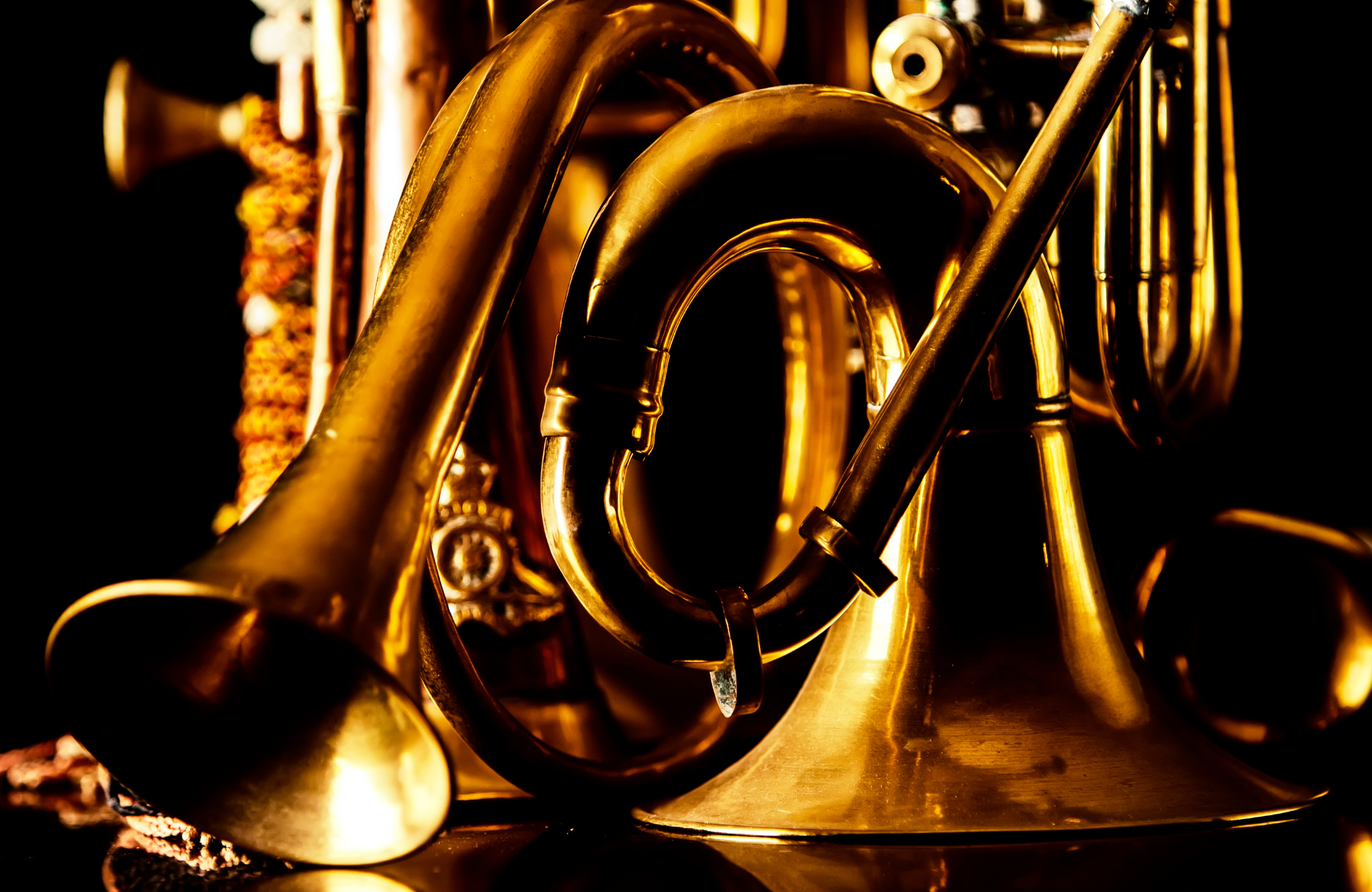The Syracuse Orchestra performs on the Village Green. Enjoy light classical favorites, patriotic tunes, and popular standards. All ages are welcome for a relaxed evening of music. This concert is free to attend and you do not need a ticket.
PROGRAM
SMITH: Star Spangled Banner
BERNSTEIN: Candide Overture
SAINT-SAENS: Samson et Dalila: Bacchanale
BRAHMS: Symphony No. 2, Mvt. 3
COLERIDGE-TAYLOR: Four Characteristic Waltzes (Selections)
COPLAND: Rodeo: Buckaroo Holiday
INTERMISSION
BERNSTEIN: The Magnificent Seven
ANDERSON: Summer Skies
O’LOUGHLIN: Onward
ROGERS/CUSTER: Carousel Waltz
SOUSA: Fairest of the Fair
CUSTER: Dixieland Parade
SOUSA: Stars and Stripes Forever
Thanks to our Summer Concert Series sponsors!

PROGRAM NOTES
LEONARD BERNSTEIN (1918-1990) Candide Overture
Leonard Bernstein was perhaps best known for his tenure as music director of the New YorkPhilharmonic Orchestra, which he led from 1958 to 1969. Bernstein was passionate about teaching. He felt that every composition had a story, and he was keen on sharing those stories with the orchestra itself, with his concert audiences, and with children, through his Young People’s Concerts broadcast on network television. Bernstein often conducted from the piano, which allowed him to combine his roles as conductor, performer, and educator. Bernstein (He) composed traditional works for solo piano, ...
LEONARD BERNSTEIN (1918-1990) Candide Overture
Leonard Bernstein was perhaps best known for his tenure as music director of the New YorkPhilharmonic Orchestra, which he led from 1958 to 1969. Bernstein was passionate about teaching. He felt that every composition had a story, and he was keen on sharing those stories with the orchestra itself, with his concert audiences, and with children, through his Young People’s Concerts broadcast on network television. Bernstein often conducted from the piano, which allowed him to combine his roles as conductor, performer, and educator. Bernstein (He) composed traditional works for solo piano, orchestra, opera, and the ballet, as well as lighter works for Broadway and film, most notably the score for West Side Story.
Candide is a contemporary operetta, a setting of Voltaire’s novella of the same name. It follows the travels and intrigues of Candide, the illegitimate nephew of a German baron, who eventually finds happiness not in power, riches, or romance, but in the simple hard work of farming. The operetta premiered on Broadway in 1956 to mixed reviews and closed after only 2 months. However, the music was well-received, and the operetta was revived and revised numerous times; it has now become a classic.
The overture opens with rhythmic punctuation by the brass and winds, over which the strings join in a marching theme, indicating the sounds of battle. The strings then play a lyrical melody from the song “Oh Happy We”, in which Candide sings of buying a farm and settling in the countryside. The string melody grows broader, alternating with sharp interjections from the winds and percussion. A marching theme re-emerges followed by passages exploring different rhythms and time signatures. Eventually the whole orchestra joins together in a rousing finale.
SAINT-SAENS: Samson et Dalila: Bacchanale
Camille Saint-Saëns was trained at the Paris Conservatoire as a composer and organist. He toured extensively as a pianist. As a composer he was a champion of the progressive works of Wagner and Liszt but later embraced traditional French musical forms.
Samson and Deliliah is a grand opera based on the biblical story from the Book of Judges, in which Delilah’s beauty and wiles outwit Samson’s strength. This Bacchanale (a musical form depicting scenes of pagan abandon or drunken revelry) appears in the final scene of the opera as the Philistines prepare to celebrate their victory over Samson and the Hebrews. The Philistine priests dance wildly just before Samson enters the Temple of Dagon to surrender. We first hear the oboe in a cadenza-like introduction. This is followed by a march tune in the winds and strings as Samson enters the temple. The music then becomes darker as it grows to include the full orchestra, eventually superimposing the oboe theme on top of the rest of the orchestra. The central section is more lyrical in the strings with percussive ornaments in the winds. We then alternate between dramatic and lyrical, followed by driving rhythms in the tympani and unison strings, and culminating in a frenetic finish as the Philistines conclude their dance.
BRAHMS: Symphony No. 2, Mvt. 3
Johannes Brahms was born into a musical family in Hamburg, Germany. After touring Europe and meeting many prominent musicians of the day, he moved to Vienna. He worked as conductor of vocal music and wrote much music for vocal ensemble during this period. He was a perfectionist who labored long over each piece before he was willing to publish it and was known to discard large amounts of music he was not happy with. He took the mantle of German composers Haydn, Beethoven, and Schumann in pursuing traditional forms, in contrast to other musicians of the day who were moving away from classical structures in their music. While Brahms used traditional symphonic forms, he explored variation in novel ways within that structure.
Brahms’ labored for two decades on his First Symphony. Only a year after the first his Second Symphony was premiered. This symphony has moments of pastoral feel alternating with heavier moments in the brass and timpani. Brahms himself referred to his 2nd symphony as “the lovely monstrosity”. We will hear the third movement, which begins in the brisk triple time of a scherzo but moves into several different time signatures and tempos before ending serenely and quietly.
COLERIDGE-TAYLOR: Four Characteristic Waltzes (Selections)
Samuel Coleridge-Taylor was born in London. He was named for the poet Samuel Taylor Coleridge. His mother was British, and his father was from Sierra Leone, but his ancestors had been enslaved in the American colonies before attaining freedom and moving to Nova Scotia, then back to Africa. He showed musical aptitude at a young age and began taking violin lessons. He began studying at the Royal College of Music at age 15, quickly moving from violin to composition. His work was championed by Edward Elgar and achieved wide performance in Europe and the Americas. Coleridge-Taylor made three concert tours of the US, where he was invited to the White House by Theodore Roosevelt and became acquainted with the activist W.E.B Dubois, who inspired Coleridge-Taylor to advocate for respect and dignity for people of color in both the US and the UK.
The Four Characteristic Waltzes are a relatively early composition, published the year following Coleridge-Taylor’s graduation from the Royal College. They were composed as concert waltzes rather than for dancing.
COPLAND: Rodeo: Buckaroo Holiday
Aaron Copland was born and raised in Brooklyn, the youngest of five children. His early
musical training came from his older sister. He later studied with Rubin Goldmark in New York and with Nadia Boulanger in Paris. On returning to the US, he developed a distinctly American musical sensibility, incorporating folk and jazz themes into much of his music. In his later years, he turned from composing to conducting and served as a frequent guest conductor throughout the US and Europe.
Rodeo is a ballet in 5 sections. It was initially choreographed by Agnes DeMille for the renowned Ballet Russe, with DeMille herself dancing the lead role. Copland’s composition makes extensive use of folk tunes, often incorporating them wholesale. The first section, Buckaroo Holiday, starts with a fanfare in the brass and strings, progresses through quiet conversational episodes depicting the courtship of a cowboy by a cowgirl, then returns to the rhythmic fanfare incorporating the slapstick to evoke the whip as the horses ride away.
BERNSTEIN: The Magnificent Seven
Elmer Bernstein was an American composer who studied under Aaron Copland, served in the US Military writing music for Armed Forces radio, and who achieved his greatest fame writing for Hollywood movies. He wrote and arranged more than 150 scores for films as diverse as The Ten Commandments, My Left Foot, Airplane! and Ghostbusters. He is not related to Leonard Bernstein though they lived at the same time and are sometimes referred to as “Bernstein East” (Leonard) and “Bernstein West” (Elmer)
The Magnificent Seven is an Old American Western retelling of the classic Kurosawa film The Seven Samurai. It depicts seven gunslingers hired to protect a village from Marauding Bandits. We first hear the strings and winds setting the scenes, followed by strong rhythms in the brass and woodwinds with the strings soaring over the top in a lyrical theme. We then hear the brass taking over the theme in mariachi style. The strings evoke marauding bandits, followed by the return of the heroic theme.
LEROY ANDERSON (1908-1975): Summer Skies
Leroy Anderson grew up in Cambridge, Massachusetts. He was raised in a musical family, playing mandolin, trombone, and string bass as a child. He graduated from Harvard and went on to serve as a translator and intelligence officer in the US military. As a composer he established a strong relationship with the Boston Pops Orchestra which premiered many of his compositions. He is known best for his many “orchestral miniatures,” accessible pieces which explore texture and rhythm. His music has been used heavily in radio, television, and film.
Summer Skies is a lyrical piece with the primary melody in the strings with occasional punctuation by percussion and supporting chords in the winds. It was written while Anderson was living in Woodbury, Connecticut awaiting the completion of his custom built summer home.
O’LOUGHLIN: Onward
Sean O’Loughlin was born in Syracuse and has devoted many years to the local music scene, serving as Principal Pops Conductor for Syracuse Orchestra and appearing on stage on the Hamilton Village Green several times. He is in demand across the country and worldwide as a conductor and composer.
Onward was premiered this past year at the Syracuse Orchestra’s gala event. Much of O’Loughlin’s music is movie-music inspired, and this particular work was commissioned by one the orchestra’s board members. “Our former music librarian (who passed away in 2016), always used to say “Onward” when we got the orchestra started, and the title of the work is related to that spirit of dedication”.
Richard Rogers 1902-1979/Calvin Custer 1939-1998
Carousel Waltz 1945/arr 1997
Richard Rogers was an iconic American composer who wrote primarily for musicals with his partners Oscar Hammerstein and Lorenz Hart. The plot of Carousel revolves around the romance between a circus barker and a mill worker. Instead of opening with a traditional overture, the musical begins with the Carousel Waltz, performed as a ballet, with characters interacting around the circus grounds. This arrangement is by long-time Syracuse collaborator Calvin Custer.
JOHN PHILLIP SOUSA (1854-1932) Fairest of the Fair
Sousa began his musical training on the violin at age 6. He soon learned a variety of wind and string instruments. At the age of 13, his father, a trombonist in the US Marine Band, enlisted the young Sousa in the Marine Band as an apprentice. After serving his apprenticeship, he joined a theater pit orchestra, where he learned to conduct. He later returned to the Marine Band conducting and composing music of various genres. His many familiar marches for military band have earned him the title “March King”.
Fairest of the Fair was composed for the annual Boston Food Fair in 1908. Sousa completed this march while on Saranac Lake NY that summer. The opening theme is typical of Sousa’s military marches. The secondary theme is more lyrical. We hear the two styles alternating through the course of the march.
CUSTER: Dixieland Parade
Calvin Custer attended Carnegie Mellon University and Syracuse University. He was associated with the Syracuse Symphony Orchestra during the majority of his musical career serving in the keyboard, horn and string bass sections, holding various conducting positions, and serving as staff arranger. He helped to implement the orchestra’s chamber music program which continues to perform in local schools and libraries to this day. Custer was prolific in his creations of arrangements for orchestra, many of which were performed by orchestras across the country including the Boston Pops Orchestra.
In Dixieland Parade, Custer evokes the sound of a dixieland band, featuring a particularly difficult clarinet part. This is one of the orchestra’s favorite Custer works.
FEATURED ARTISTS

From conducting Broadway musicals in such venues as the Kodak Theater in Los Angeles to leading summer orchestral performances for thousands of concert-goers across Central New York, Travis understands and facilitates the important connection between audience members and orchestral musicians.
As a guest conductor with the Syracuse ...
From conducting Broadway musicals in such venues as the Kodak Theater in Los Angeles to leading summer orchestral performances for thousands of concert-goers across Central New York, Travis understands and facilitates the important connection between audience members and orchestral musicians.
As a guest conductor with the Syracuse Symphony Orchestra, Symphoria, and The Syracuse Orchestra, Travis has led performances of a wide variety of repertoire, including Pops, Classical and Film music. He has also collaborated with well-known composers, including conducting the world premiere of Academy Award-nominated composer Patrick Doyle’s score for the silent film “IT” at the 2013 Syracuse International Film Festival.
Currently, Travis is interim Dean of the Carroll College of Arts and Sciences at Le Moyne College in Syracuse, NY, where he was the founding conductor of the Le Moyne College Symphony Orchestra. He studied violin performance and conducting at the University of North Carolina at Greensboro and also holds an BMA from Le Moyne College and PH.D. in Arts Administration from the University of Kentucky.



